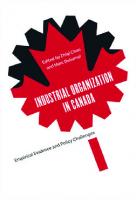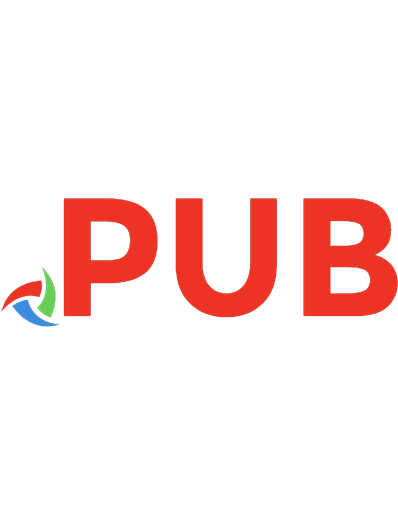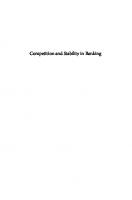Industrial Organization: Competition, Strategy and Policy 9781292121710, 9781292121758, 9781292121765, 1292121718
525 55 8MB
English Pages [881] Year 2016
Table of contents :
Cover......Page 1
Title Page......Page 4
Copyright Page......Page 5
Contents......Page 8
Preface......Page 25
Acknowledgements......Page 28
Part I: Theoretical Foundations......Page 32
1.1 Introduction......Page 34
1.2 Static and dynamic views of competition......Page 35
1.3 The structure–conduct–performance paradigm......Page 37
1.4 Strategic management: a short diversion......Page 58
Discussion questions......Page 61
Further reading......Page 62
2 Production, costs, demand and profit maximization......Page 63
2.2 Production and costs......Page 64
2.3 Demand, revenue, elasticity and profit maximization......Page 81
2.4 Summary......Page 91
Discussion questions......Page 92
Computational questions......Page 93
Further reading......Page 94
3.1 Introduction......Page 95
3.2 The neoclassical theory of the firm: historical development......Page 96
3.3 Theories of perfect competition and monopoly......Page 98
3.4 Efficiency and welfare properties of perfect competition and monopoly......Page 104
3.5 Theory of monopolistic competition......Page 110
3.6 Summary......Page 113
Computational questions......Page 114
4.1 Introduction......Page 116
4.2 Critique of the neoclassical theory of the firm......Page 117
4.3 Separation of ownership from control: managerial theories of the firm......Page 120
4.4 The behavioural theory of the firm......Page 131
4.5 Summary......Page 133
Further reading......Page 134
5.1 Introduction......Page 135
5.2 The Coasian firm......Page 136
5.3 Transaction costs and the theory of the firm......Page 140
5.4 Agency theory......Page 144
5.5 Property rights and the theory of the firm......Page 147
5.6 The resource-based theory of the firm......Page 148
5.7 Summary......Page 151
Further reading......Page 153
6.1 Introduction......Page 155
6.2 Agency problems and the need for corporate governance......Page 157
6.3 Instruments of corporate governance......Page 160
6.4 Corporate governance codes of practice......Page 164
6.5 Corporate governance: implementation and empirical evidence......Page 167
6.6 Business ethics......Page 173
6.7 Corporate social responsibility......Page 179
6.8 Summary......Page 188
Further reading......Page 190
Part II: Structural Analysis of Industry......Page 192
7 Oligopoly: non-collusive models......Page 194
7.1 Introduction......Page 195
7.2 Interdependence, conjectural variation, independent action and collusion......Page 196
7.3 Models of output determination in duopoly......Page 197
7.4 Models of price determination in duopoly......Page 209
7.5 The kinked demand curve and models of price leadership......Page 216
7.6 Summary......Page 221
Computational questions......Page 223
Further reading......Page 225
8.1 Introduction......Page 226
8.2 Collusive action and collusive forms......Page 227
8.3 Collusive institutions......Page 231
8.4 Profit-maximizing models of price and output determination for a cartel......Page 234
8.5 Other motives for collusion......Page 238
8.6 Factors conducive to cartel formation......Page 241
8.7 Influences on cartel stability......Page 246
8.8 Summary......Page 256
Further reading......Page 257
9 Game theory......Page 259
9.1 Introduction......Page 260
9.2 Dominance and Nash equilibrium......Page 261
9.3 The prisoner’s dilemma game......Page 266
9.4 Mixed strategies......Page 270
9.5 Sequential games......Page 277
9.6 Repeated games......Page 284
9.7 Summary......Page 286
Discussion questions......Page 287
Computational questions......Page 288
Further reading......Page 290
10.1 Introduction......Page 291
10.2 Market and industry definition......Page 292
10.3 Official schemes for industry classification......Page 295
10.4 Measures of seller concentration......Page 298
10.5 Interpretation of concentration measures......Page 313
10.6 Summary......Page 315
Further reading......Page 316
11 Determinants of seller concentration......Page 317
11.2 Seller concentration: systematic determinants......Page 318
11.3 The random growth hypothesis......Page 326
11.4 Trends in concentration and the location of industry......Page 335
11.5 Summary......Page 351
Discussion questions......Page 353
Further reading......Page 354
12.1 Introduction......Page 355
12.2 Types of barrier to entry......Page 357
12.3 Entry-deterring strategies......Page 368
12.4 Signalling commitment......Page 373
12.5 Potential entry and contestability......Page 376
12.6 Entry and industry evolution......Page 378
12.7 Empirical evidence on entry......Page 380
12.8 Summary......Page 386
Further reading......Page 388
13.1 Introduction......Page 390
13.2 Empirical tests of the SCP paradigm......Page 391
13.3 Strategic groups......Page 397
13.4 Sources of variation in profitability: industry, corporate and business unit effects......Page 398
13.5 The new empirical industrial organization (NEIO)......Page 403
13.6 The persistence of profit......Page 410
13.7 Summary......Page 415
Further reading......Page 417
Part III: Analysis of Firm Strategy......Page 420
14.1 Introduction......Page 422
14.2 Cost plus pricing......Page 423
14.3 Price discrimination......Page 428
14.4 Peak-load pricing......Page 444
14.5 Transfer pricing......Page 448
14.6 Price dispersion......Page 457
14.7 Summary......Page 459
Discussion questions......Page 462
Computational questions......Page 463
Further reading......Page 464
15.1 Introduction......Page 466
15.2 Auction formats and models of bidders’ valuations......Page 468
15.3 The pure common value model and the winner’s curse......Page 470
15.4 Optimal bidding strategies and revenue equivalence in the independent private values model......Page 473
15.5 Extensions and additional topics in auction theory......Page 480
15.6 Empirical evidence......Page 485
15.7 Summary......Page 493
Computational questions......Page 495
Further reading......Page 496
16.1 Introduction......Page 497
16.2 Types of product differentiation......Page 499
16.3 Monopolistic competition revisited: the socially optimal amount of product differentiation......Page 501
16.4 Lancaster’s product characteristics model......Page 504
16.5 Hotelling’s location model......Page 511
16.6 Salop’s location model......Page 523
16.7 Summary......Page 527
Discussion questions......Page 529
Further reading......Page 530
17.1 Introduction......Page 531
17.2 Determinants of advertising expenditure......Page 534
17.3 Advertising and product characteristics......Page 543
17.4 Advertising and profit maximization......Page 545
17.5 Advertising as a barrier to entry......Page 551
17.6 Advertising, information search and quality signalling......Page 553
17.7 Is there too much advertising?......Page 556
17.8 Empirical evidence......Page 560
17.9 Summary......Page 563
Discussion questions......Page 564
Further reading......Page 565
18.1 Introduction......Page 566
18.2 Market structure, firm size and the pace of technological change......Page 567
18.3 Investment in research and development......Page 584
18.4 Diffusion......Page 591
18.5 Patents......Page 597
18.6 Empirical evidence......Page 602
18.7 Summary......Page 608
Discussion questions......Page 610
Further reading......Page 611
19.1 Introduction......Page 613
19.2 Profit-maximizing motives for horizontal mergers......Page 615
19.3 Non-profit-maximizing motives for horizontal mergers......Page 621
19.4 Merger waves......Page 625
19.5 Strategic alliances......Page 628
19.6 Horizontal mergers: some empirical evidence......Page 630
19.7 Summary......Page 632
Discussion questions......Page 633
Further reading......Page 634
20.1 Introduction......Page 635
20.2 Motives for vertical integration: enhancement of market power......Page 636
20.3 Motives for vertical integration: cost savings......Page 643
20.4 Vertical disintegration......Page 651
20.5 Empirical evidence on vertical integration......Page 652
20.6 Agency and vertical relationships......Page 653
20.7 Summary......Page 661
Discussion questions......Page 662
Further reading......Page 663
21.1 Introduction......Page 664
21.2 Motives for vertical restraints......Page 665
21.3 Forms of vertical restraint......Page 668
21.4 Summary......Page 678
Further reading......Page 679
22.1 Introduction......Page 680
22.2 Demand for a network product or service......Page 682
22.3 Market equilibrium price and quantity for a network good or service: perfect competition and monopoly......Page 689
22.4 Market equilibrium price and quantity for a network good or service: duopoly......Page 694
22.5 Forms of competition over standardization and compatibility......Page 699
22.6 Summary......Page 702
Further reading......Page 704
23.1 Introduction......Page 706
23.2 Types of diversification......Page 707
23.3 Motives for diversification......Page 709
23.4 Corporate focus and deconglomeration......Page 719
23.5 Empirical evidence......Page 722
23.6 The multinational enterprise......Page 727
23.7 Summary......Page 734
Further reading......Page 736
Part IV: Analysis of Public Policy......Page 738
24 Competition policy......Page 740
24.2 Competition policy: theoretical framework......Page 741
24.3 Elements of competition policy......Page 748
24.4 Implementation of competition policy......Page 751
24.5 Summary......Page 768
Further reading......Page 770
Appendices: Analytical Tools......Page 772
Appendix 1 Mathematical methods......Page 774
Appendix 2 Econometric methods......Page 797
Appendix 3 Computational Solutions......Page 807
Glossary......Page 812
Bibliography......Page 824
Index......Page 864




![Trade, Industrial Policy, and International Competition, Second Edition [1 ed.]
9780773597709, 9780773545960](https://dokumen.pub/img/200x200/trade-industrial-policy-and-international-competition-second-edition-1nbsped-9780773597709-9780773545960.jpg)





